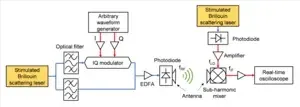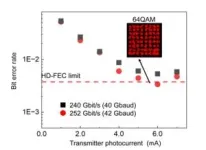(Press-News.org) DURHAM, N.C. – A black sedan cruises silently down a quiet suburban road, driver humming Christmas carols quietly while the car’s autopilot handles the driving. Suddenly, red flashing lights and audible warnings blare to life, snapping the driver from their peaceful reprieve. They look at the dashboard screen and see the outline of a car speeding toward them for a head-on collision, yet the headlights reveal nothing ahead through the windshield.
Despite the incongruity, the car’s autopilot grabs control and swerves into a ditch. Exasperated, the driver looks around the vicinity, finding no other vehicles as the incoming danger disappears from the screen. Moments later, the real threat emerges — a group of hijackers jogging toward the immobilized vehicle.
This scene seems destined to become a common plot point in Hollywood films for decades to come. But due to the complexities of modern automotive detection systems, it remains firmly in the realm of science fiction. At least for the moment.
Engineers at Duke University, led by Miroslav Pajic, the Dickinson Family Associate Professor of Electrical and Computer Engineering, and Tingjun Chen, assistant professor of electrical and computer engineering, have now demonstrated a system they’ve dubbed “MadRadar” for fooling automotive radar sensors into believing almost anything is possible.
The technology can hide the approach of an existing car, create a phantom car where none exists or even trick the radar into thinking a real car has quickly deviated from its actual course. And it can achieve this feat in the blink of an eye without having any prior knowledge about the specific settings of the victim’s radar, making it the most troublesome threat to radar security to date.
The researchers say MadRadar shows that manufacturers should immediately begin taking steps to better safeguard their products.
The research will be published in 2024 Network and Distributed System Security Symposium, taking place February 26 – March 1 in San Diego, California.
“Without knowing much about the targeted car’s radar system, we can make a fake vehicle appear out of nowhere or make an actual vehicle disappear in real-world experiments,” Pajic said. “We’re not building these systems to hurt anyone, we’re demonstrating the existing problems with current radar systems to show that we need to fundamentally change how we design them.”
In modern cars that feature assistive and autonomous driving systems, radar is typically used to detect moving vehicles in front of and around the vehicle. It also helps to augment visual and laser-based systems to detect vehicles moving in front of or behind the car.
Because there are now so many different cars using radar on a typical highway, it is unlikely that any two vehicles will have the exact same operating parameters, even if they share a make and model. For example, they might use slightly different operating frequencies or take measurements at slightly different intervals. Because of this, previous demonstrations of radar-spoofing systems have needed to know the specific parameters being used.
“Think of it like trying to stop someone from listening to the radio,” explained Pajic. “To block the signal or to hijack it with your own broadcast, you’d need to know what station they were listening to first.”
In the MadRadar demonstration, the team from Duke showed off the capabilities of a radar-spoofing system they’ve built that can accurately detect a car’s radar parameters in less than a quarter of a second. Once they’ve been discovered, the system can send out its own radar signals to fool the target’s radar.
In one demonstration, MadRadar sends signals to the target car to make it perceive another car where none actually exist. This involves modifying the signal’s characteristics based on time and velocity in such a way that it mimics what a real contact would look like.
In a second and much more complicated example, it fools the target’s radar into thinking the opposite — that there is no passing car when one actually does exist. It achieves this by delicately adding masking signals around the car’s true location to create a sort of bright spot that confuses the radar system.
“You have to be judicious about adding signals to the radar system, because if you simply flooded the entire field of vision, it’d immediately know something was wrong,” said David Hunt, a PhD student working in Pajic’s lab.
In a third kind of attack, the researchers mix the two approaches to make it seem as though an existing car has suddenly changed course. The researchers recommend that carmakers try randomizing a radar system’s operating parameters over time and adding safeguards to the processing algorithms to spot similar attacks.
“Imagine adaptive cruise control, which uses radar, believing that the car in front of me was speeding up, causing your own car to speed up, when in reality it wasn’t changing speed at all,” said Pajic. “If this were done at night, by the time your car’s cameras figured it out you’d be in trouble.”
Each of these attack demonstrations, the researchers emphasize, were done on real-world radar systems in actual cars moving at roadway speeds. It’s an impressive feat, given that if the spoofing radar signals are even a microsecond off the mark, the fake datapoint would be misplaced by the length of a football field.
“These lessons go far beyond radar systems in cars as well,” Pajic said. “If you want to build drones that can explore dark environments, like in search and rescue or reconnaissance operations, that don’t cost thousands of dollars, radar is the way to go.”
This research was supported by the Office of Naval Research (N00014-23-1-2206, N00014-20-1-2745), the Air Force Office of Scientific Research (FA9550-19-1-0169), the National Science Foundation (CNS-1652544, CNS-2211944), and the National AI Institute for Edge Computing Leveraging Next Generation Wireless Networks (Athena) (CNS-2112562).
CITATION: “MadRadar: A Black-Box Physical Layer Attack Framework on mmWave Automotive FMCW Radars,” David Hunt, Kristen Angell, Zhenzhou Qi, Tingjun Chen, and Miroslav Pajic. Network and Distributed System Security Symposium (NDSS) 2024. DOI: 10.14722/ndss.2024.24135
# # #
END
Engineers develop hack to make automotive radar hallucinate
Researchers trick automotive radar in real-time with no prior knowledge about the system to demonstrate vulnerabilities that need addressed
2024-01-31
ELSE PRESS RELEASES FROM THIS DATE:
Strong European backing for Ukraine leaves “little space” for exploitation of pro-Russian politics, study shows
2024-01-31
Strong support for Ukraine means there is “little space” for European politicians to exploit pro-Russia foreign policy messages, a new study shows.
Researchers have found widespread backing for Ukraine across the continent, and for policies that help the nation, such as imposing sanctions on Russia.
But public opinion is more mixed on the approach NATO should take and whether Ukraine should become a member.
Experts found European nations can be classified into three distinct groups. Citizens ...
Did dementia exist in ancient Greek and Rome?
2024-01-31
You might think age-related dementia has been with us all along, stretching back to the ancient world.
But a new analysis of classical Greek and Roman medical texts suggests that severe memory loss — occurring at epidemic levels today — was extremely rare 2,000 to 2,500 years ago, in the time of Aristotle, Galen and Pliny the Elder.
The USC-led research, published in the Journal of Alzheimer’s Disease, bolsters the idea that Alzheimer’s disease and related dementias are diseases of modern environments and lifestyles, with sedentary behavior and exposure to air pollution largely to blame.
“The ancient Greeks had very, very few — but we found them ...
Surgeons’ choice of skin disinfectant impacts infection risk, Canadian-American study shows
2024-01-31
Does the type of solution used by surgeons to disinfect skin before surgery impact the risk of surgical site infection? According to new research from an international trial jointly led by McMaster University and the University of Maryland School of Medicine – yes, it does.
Researchers of the PREPARE trial, which enrolled nearly 8,500 participants at 25 hospitals in Canada and the United States, found the use of iodine povacrylex in alcohol to disinfect a patient’s skin could prevent surgical site infection in thousands of patients undergoing surgery for a closed ...
Trees struggle to ‘breathe’ as climate warms, researchers find
2024-01-31
UNIVERSITY PARK, Pa. — Trees are struggling to sequester heat-trapping carbon dioxide (CO2) in warmer, drier climates, meaning that they may no longer serve as a solution for offsetting humanity’s carbon footprint as the planet continues to warm, according to a new study led by Penn State researchers.
“We found that trees in warmer, drier climates are essentially coughing instead of breathing,” said Max Lloyd assistant research professor of geosciences at Penn State and lead author on the study recently published in Proceedings of the National Academy of Sciences. “They are sending CO2 right back into the ...
New study has promising results for anti-aging effects from enzymatically modified isoquercitrin
2024-01-31
From the study:
This research examines the anti-aging potential of the flavonoid derivative of isoquercitrin known as enzymatically modified isoquercitrin (EMIQ).
A 28-day clinical trial with 30 volunteers aged 31–55 years highlighted EMIQ's effectiveness. Participants using EMIQ-containing Essence displayed reduced facial trans-epidermal water loss and skin roughness, alongside improved skin elasticity. This study emphasizes EMIQ's potential as an anti-photoaging ingredient in cosmetics, warranting further research. The findings pave the way for developing innovative skincare products addressing photoaging effects. ...
Ketamine helped many severely depressed veterans, study shows
2024-01-31
Ketamine has received a lot of attention as a potential treatment for depression, but few studies have revealed how well it works in real world settings, especially in patients with complex mental health needs.
Now, a new study of data from veterans who had tried many depression treatments but still had severe symptoms suggests a series of intravenous doses of ketamine gave many at least partial relief. For a minority, it led to full remission.
Nearly half of 215 veterans with treatment resistant depression who received ...
Bringing order to disordered proteins
2024-01-31
Protein molecules lie at the heart of biology. Our typical understanding of proteins states that each type of protein has a specific three-dimensional shape that enables it to perform its function. This dogma is challenged by intrinsically disordered proteins which make up one third of all proteins and have central biological functions even though their shapes are constantly changing. Until now, our understanding of the structural properties of this intriguing class of proteins has been based on studies ...
A cholesterol precursor mediates sensitivity to cell death by ferroptosis
2024-01-31
A team of scientists from the University of Ottawa, and researchers from other universities and research centres around the world, have discovered that 7-dehydrocholesterol (7-DHC) is an endogenous suppressor of ferroptosis, which could have important implications for the treatment of cell death-related diseases.
Ferroptosis is a form of cell death that is characterized by the accumulation of lipid peroxides and iron-dependent reactive oxygen species (ROS) in cells. It is a regulated process that is distinct from other forms of cell death, such as apoptosis and necrosis.
The researchers identified a pro-ferroptotic activity of 7-dehydrocholesterol reductase (DHCR7) ...
Rice study shows how allyship can combat discrimination in STEM for Blacks, Latinos
2024-01-31
Calling out discriminatory behavior is an effective way for white students to help combat racism against Black and Latino science, technology, engineering and math (STEM) students, according to new research from Rice University.
“(Absent) Allyship in STEM: Can Psychological Standing Increase Prejudice Confrontation?” appears in a recent edition of the Journal of Business and Psychology. The research, led by Eden King and Mikki Hebl from Rice, examines whether Black and Latino college students face discrimination when studying STEM and how allies can help combat racist behavior in these situations.
“There is already a serious lack of representation ...
Drug overdose cardiac arrests involve younger, healthier people than other cardiac arrests
2024-01-31
Research Highlights:
An analysis of cardiac arrest records in a U.S. registry revealed that people with drug overdose cardiac arrests were more likely to be younger, have fewer health conditions and have higher survival rates with better neurologic outcomes compared to people who experience cardiac arrest from other causes.
In addition, drug overdose cardiac arrests were less likely to be witnessed and less likely to present with a shockable first monitored heart rhythm, meaning a heart rhythm that is able to respond to a defibrillator.
Embargoed until 4 a.m. CT/5 a.m. ET Wednesday, January 31, 2024
DALLAS, Jan. 31, 2024 — An analysis of data for more ...
LAST 30 PRESS RELEASES:
Post-stroke injection protects the brain in preclinical study
Cardiovascular risk score predicts multiple eye diseases
Health: estimated one in ten British adults used or interested in GLP-1 medications for weight loss
Exercise to treat depression yields similar results to therapy
Whooping cough vaccination for pregnant women strengthens babies’ immune system
Dramatic decline in new cases of orphanhood in Uganda driven by HIV treatment and prevention programs
Stopping weight loss drugs linked to weight regain and reversal of heart health markers
Higher intake of food preservatives linked to increased cancer risk
Mass General Brigham–developed cholera vaccine completes phase 1 trial
First experimental validation of a “150-year-old chemical common sense” direct visualization of the molecular structural changes in the ultrafast anthracene [4+4] photocycloaddition reaction
Lack of support for people on weight loss drugs leaves them vulnerable to nutritional deficiencies, say experts
Dogs’ dinners can have greater climate impact than owners’
Are you ready to swap salmon for sprats and sardines?
1.6 million UK adults used weight loss drugs in past year
American College of Cardiology comments on new dietary guidelines for Americans
American Society of Gene & Cell Therapy and Orphan Therapeutics Accelerator partner to advance and commercialize promising rare disease treatments
One in 14 patients having day case surgery have new or worse chronic pain 3 months after their operation
New study highlights link between eviction rates and gun violence
Heatwaves heat up soil but not toxin levels in rice, study finds
Digital modeling reveals where construction carbon emissions really come from
Turning farm waste into water filters
New study shows how the spleen helps the immune system accept a transplant
New Mayo Clinic study advances personalized prostate cancer education with an EHR-integrated AI agent
Researchers identify novel therapeutic target to improve recovery after nerve injury
Microbes in breast milk help populate infant gut microbiomes
Reprogramming immunity to rewrite the story of Type 1 diabetes
New tool narrows the search for ideal material structures
Artificial saliva containing sugarcane protein helps protect the teeth of patients with head and neck cancer
Understanding the role of linear ubiquitination in T-tubule biogenesis
Researchers identify urban atmosphere as primary reservoir of microplastics
[Press-News.org] Engineers develop hack to make automotive radar hallucinateResearchers trick automotive radar in real-time with no prior knowledge about the system to demonstrate vulnerabilities that need addressed




